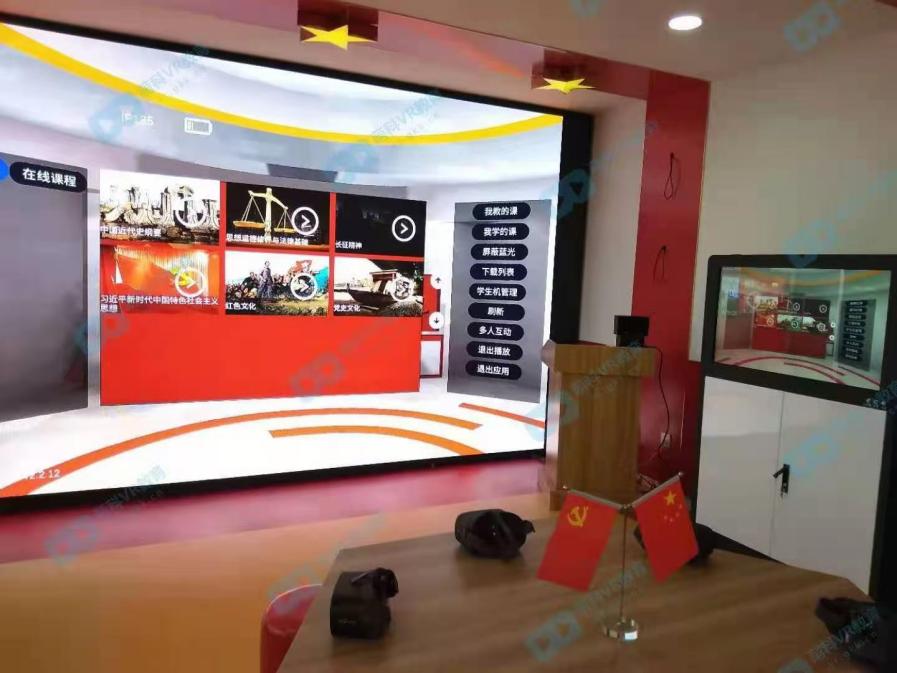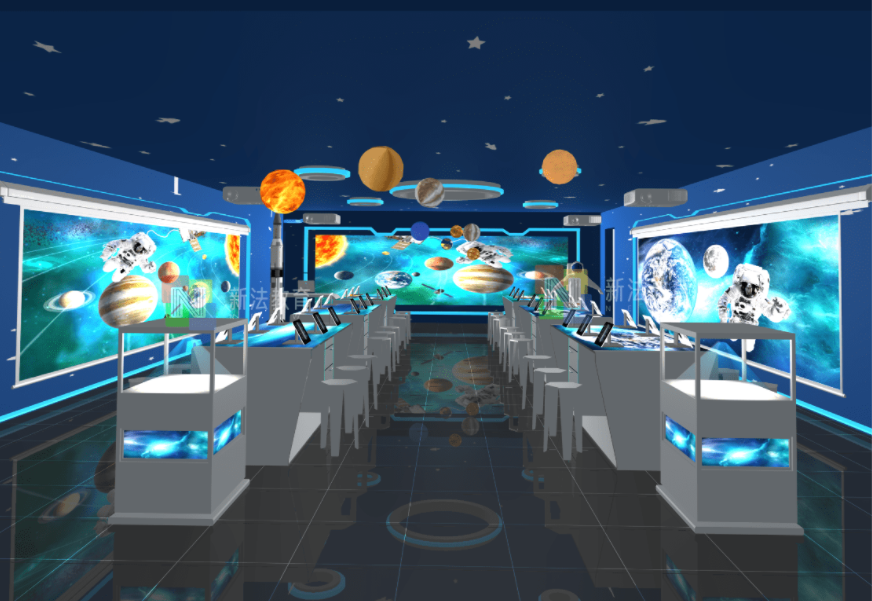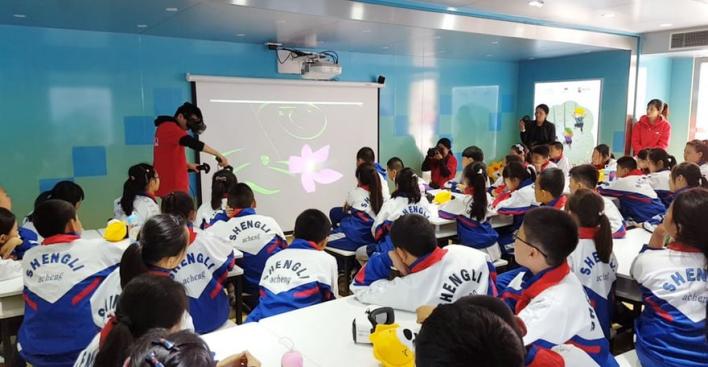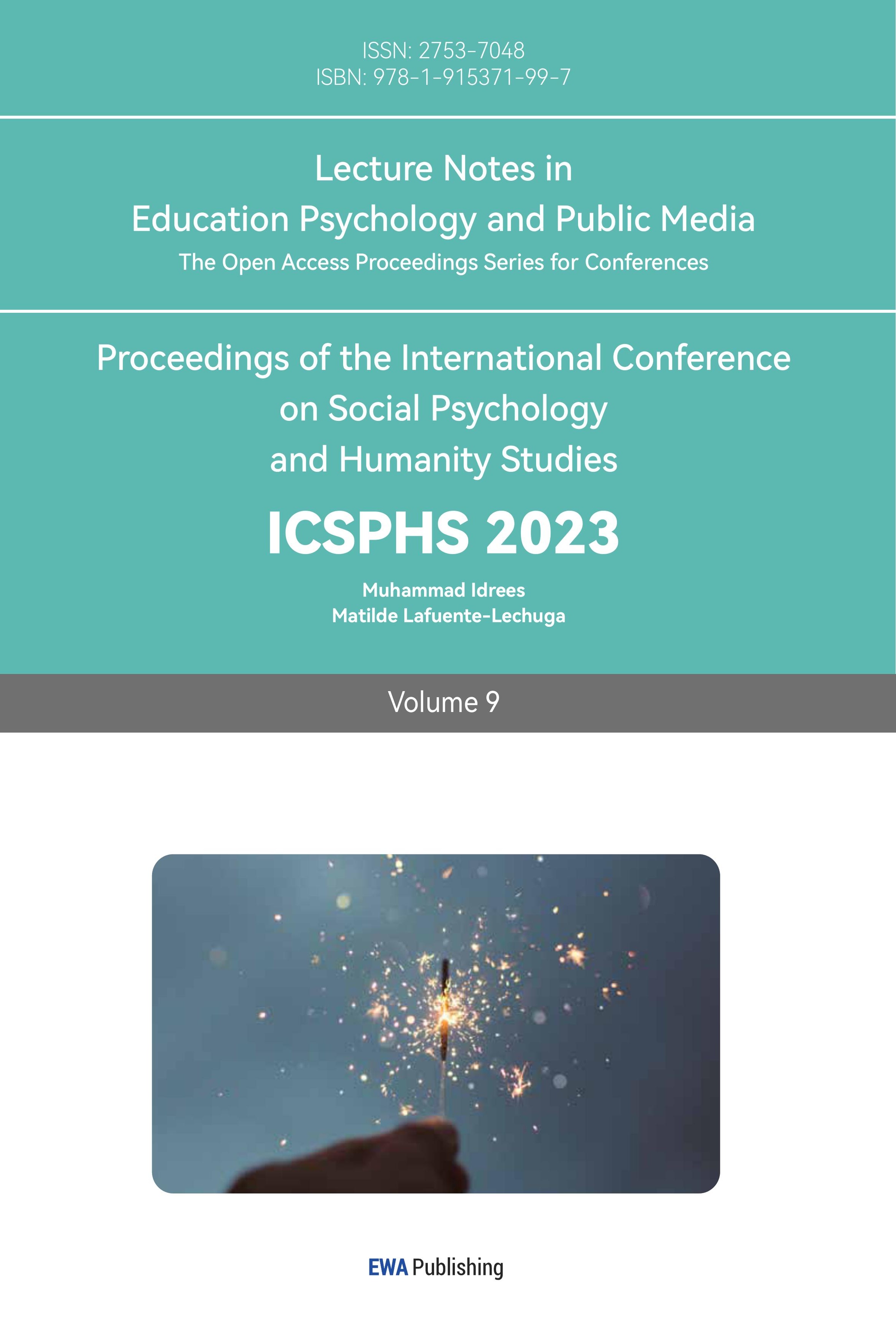1. Introduction
VR (Virtual Reality) is an interactive digital pseudo environment, which can dynamically adjust the image presentation according to the user's sensory feedback, and improve the user's perception through immersive experience. Relying on immersion and pseudo environment, VR has occupied the sales advantage of the market [1]. The development of the entire technology industry has been renovated. Moreover, the high-speed information exchange has pushed the media news to the public, which is in line with the general development of today's society, is popular with young people, and has also helped the technology market open new ideas. VR is highly compatible with other software and promotes the development of other commodities while developing itself [2].
This paper will investigate and evaluate three current uses of VR in education—ideological education, art education, and educational video games. The first step is to analyze how virtual reality technology is being used in ideological and ideological teaching. We examine the significant contribution that virtual reality technology has made to the study of art. The game's teaching application is then detailed, with the design idea focusing on educational and teaching goals. The performance of virtual reality technology in the sphere of art is then summarized.
2. Application of VR in Ideological Education
The disadvantage of ideological education is that it can't immerse people, so it leads to incomprehensibility and unwillingness to participate in it. With ideological education, we can further use the characteristics of VR immersion to further interact with people, strengthen students' sense of theoretical identity.
It also determines the general trend of ideological education after the Communist Party of China. From the perspective of performance assessment and ideological understanding evaluation, 20% of the students who have obtained excellent evaluation, 28% of the students who have obtained good evaluation, 44% of the students who have obtained qualified evaluation, and 8% of the students who have not obtained qualified evaluation without using virtual technology. The overall evaluation level of the students is low; However, with the introduction of VR technology to assist the ideological and ideological education of party building, the students' performance has improved significantly, with 28% of the students receiving excellent evaluation, up 8 percentage points year on year; The proportion of students with good evaluation was 38%, up 10 percentage points year on year; The percentage of students passing the evaluation was 30%, a decrease of 14 percentage points; Only 4% of the students failed to pass the evaluation. At the same time, the development of VR technology has made the teaching scene of ideological education three-dimensional and improved the common feelings of students. VR helps the ideological education in colleges and universities to have its unique leading position in the times, and has gained unique advantages, which has promoted the deepening of communist ideology (Figure 1) [3]. For example, VR technology is used to create historical scenes in the War to Resist US Aggression and Aid Korea. For example, Yang Gensi, the national super hero, sticks to the fighting environment in the small ridge battle on the southeast side of 1071.1 highland by the Changjin Lake, so that students can experience the battle process of fighting back eight attacks of the US military led by martyr Yang Gensi in order to ensure the completion of the battle plan of large forces under the condition of great disparity between the enemy and ourselves.

Figure 1: VR technology: A "New Engine" of social ideological and political education.
3. Application of VR in Art Education
For art education, the development of VR technology has opened up many possibilities. Dividing them into two categories, one is the presentation of traditional art on VR devices and the other is the creation of VR art.
The development of VR technology brings new ways to present traditional art. First, VR technology helps educated people learn in an immersive and more detailed way. Traditional static works of art, such as paintings, can be studied in closer proximity and in greater detail when presented through VR. On October 24, 2019, the Louvre, an important historical site in Paris, France, and one of the world's largest art museums, teamed up with HTC VIVE Arts and VR studio Emissive to create the first virtual reality experience -Mona Lisa: Transboundary Vision [4]. The immersive experience allows visitors to see this stunning work of Leonardo da Vinci up close and personal in an unprecedented way. And like performing arts, the same can be presented through VR technology. LIVR is the world's first virtual reality content platform dedicated to theatre (Figure 2). It offers a fully immersive 360° VR experience that transports you into the audience at some of the best live performances. There is no doubt that this is a boon for theatre learners. Immersive VR technology more fully helps them to record many plays that are difficult to perform again and gives them the opportunity to watch them repeatedly.

Figure 2: Immersive VR classroom.
Secondly, virtual reality, allows arts education to transcend the limits of distance. The Disklavier piano developed by Yamaha helped the Freiburg Conservatory of Music in Germany to conduct a remote admissions exam. The collaboration took advantage of the Disklavier's VR automated playing mechanics and web link to assist both Japanese and Chinese candidates to successfully take the exams distantly. This technology can be used not only for remote exams, but also for remote master classes, remote concerts, and many other aspects [5]. As early as 2019, Inna Falix, head of the piano department at the UCLA School of Music, has been teaching students from the Central Conservatory of Music in China via Internet distance technology at the school's Austin Music Center.
Furthermore, the educated can understand the knowledge more intuitively through the presentation of VR images. Virtual reality can be used in new ways in vocal music teaching. In ordinary vocal music teaching, when the teacher demonstrates, students do not intuitively understand the teacher's pronunciation style, but can only try to imitate it. With VR glasses as a carrier, students can clearly and intuitively understand the vocal principles and methods and improve the practice efficiency (Figure 3).
In general, compared with traditional education, VR education can break through the time and space limitations in some scenarios and bring students an immersive 3D virtual experience, and VR education scenarios are accelerating.

Figure 3: VR innovation classroom.
And now the development of VR technology has led to the gradual development of a unique field - VR art.
In 2016, the first year of VR, Disney's chief animator, "the father of the Little Mermaid "Glen Keane through virtual reality glasses and software programs to achieve the creation of 3D painting in virtual space, subverting the traditional creation of animators at the time. Glen Keane said: "It can't be described as painting, it's almost like sculpting." "Virtual reality technology opened the door for the imagination to move from paper to a whole new creative space." The space-breaking VR technology generates three-dimensional virtual space through computer simulation, allowing art creators to immerse themselves in an enclosed space and communicate with their own hearts [6]. The artist puts on a VR headset and enters a dark, enclosed three-dimensional space to create, where the entire virtual space can be used as a drawing board, and the handheld controller is a palette and brush to paint in a more three-dimensional way based on the imagination in his or her head. Several platforms are created and allowed to use now.
Even though there are so many benefits to art education through VR, now, its popularity is still difficult to achieve.
The first is the imperfection and unpopularity of the hardware. VR equipment hardware is bulky and lacks aesthetics. And its expensive price causes users who want to try it to be discouraged. Some people have "motion sickness" when using VR devices - seeing things that do not match the default physical principles of reality - resulting in the low penetration and inefficiency of VR devices.
Second, even though there is a lot of content related to VR art education mentioned above, their richness and irreplaceability in education is still low. There is no complete real estate system resulting in fewer content creators.
In order to promote VR art education on popularization, building a virtual spot art and design education dissemination platform becomes a necessary part. Teachers can show the characteristics and development history of different types of art with panoramic VR technology as a unit for each major direction of art and design, so that students can roam independently and observe related contents from multiple angles. The simulation sub-presentation system of each art and design education established by VR technology can present the development history of art and design, the characteristics of each specialty, and the contents of the specialty. At the same time, teachers can also set up virtual simulation experience projects, and students can have an immersive experience through the PC terminal or offline VR terminal [7].
In summary, VR art education has the advantages of being immersive, detailed, and unrestricted by space and time, and further promotes the development of emerging VR art. In order to realize art education that combines reality and imagination, the construction of hardware and VR software platforms remains the goal of VR art education progress.
4. The Application of VR in Game Education
With the development of digital high-tech and the gradual improvement of the concept of meta universe, the field of virtual reality game education has been increasingly discovered by Internet giants. The field of virtual reality game education also began to develop the frontier technology of psychological and physical quality education for young people. At present, virtual reality game education can enhance students' learning, increase participation, and create new opportunities to address learning preferences.
What is more, the virtual reality game education can effectively solve the social problem of insufficient teachers and guide and train students in a more correct way based on more data analysis. In many surveys, it can also sufficiently reflect that students show more positive attitudes towards virtual reality game education. The authority believes that compared with the middle-aged and old people, teenagers have a higher degree of acceptance of new technologies and are more enthusiastic at the same time. Therefore, it is generally believed that teenagers will get higher learning enthusiasm after receiving virtual reality game education to stimulate their game potential. For future development prospects and research directions, most of researchers believe that the expensive equipment for teaching and the potential physical, physiological, and psychological problems of virtual game teaching need to be solved for students. If these problems are solved, then the educational problems such as uneven cultural development in all regions of the society can be effectively solved. At the same time, it is more convenient to ensure the safety of students in teaching and effectively promote literacy.
Additionally, many evidences show that the education which is by the virtual reality game has more benefits that the tradition education. It can more effectively deal with the unequal treatment of teachers to students and unify the teaching quality. Game teaching can also effectively stimulate students' enthusiasm for learning, thus indirectly improving students' awareness and understanding of classroom content.
About the content of virtual reality game education, the current mainstream view is to conduct specific data analysis on students to develop the most suitable and relevant disciplines for students, to cultivate top talents. The main feature of augmented reality education games that emphasize location is "environment". Learners can observe objects in 3D perspective through augmented reality technology, carry out ubiquitous learning and cooperative learning in specific environments, and learn and explore through the information provided by setting location in augmented reality. The game should also be designed with points, points, and leader boards, which are also the three elements of the gamification system [7]. The game includes static target shooting and dynamic enemy killing shooting. The latter's game design is more in line with the challenge and curiosity in the game's intrinsic motivation theory, so it is more popular with learners.
For making virtual educational games, some basic design principles need to be followed.
Firstly, designers should focus on understanding students' concrete cognition. Figurative cognition is the most beneficial way for students to improve their motivation, sense of achievement and other positive emotions in the game, and at the same time, they can obtain enough knowledge. In this respect, it is necessary to conduct an effective investigation on students [8]. The methods of investigation include but are not limited to questionnaire, understanding of students' extracurricular activities and teachers' understanding of students. After collecting enough data, we should aim at establishing the correct.
Secondly, the educational game should follow the characteristics of VR based embodied teaching application. In the initial teaching of students, we should take the right task to test students' talents. After class, follow up and observe the students' situation in class and record the test situation. According to the content of the test and the correlation between disciplines, we will evaluate and determine the teaching plan to maximize the benefits of what students can learn in the educational game [9]. For example, each student will get a life value as their initial opportunity to complete the task, and each wrong answer will lose an equal amount of life value. On the contrary, when they answer the questions correctly, they can provide some reward options for them to choose, and through these choices, the system can analyze the student's personality and combine the answers to obtain the evaluation suitable for the student.
Thirdly, it is also crucial for the guidance of educational games. Virtual learning partners should be introduced to assist students, to enhance students' sense of reality in educational games. Virtual learning partner is a virtual learning partner with VR technology that is close to or even slightly higher than distance educators [10]. This partner integrates friends, teachers, parents, and assistants to enable each student to improve himself in a tense and comfortable atmosphere. The virtual student assistant can intelligently and accurately push relevant VR education games according to the actual situation of students, thus greatly enhancing the personalized service level of the consulting platform and providing convenience and security for students' learning consulting.
All in all, virtual reality and augmented reality technology can construct virtual learning situations for learners, understand learning content in multiple directions, and combine educational game elements with intelligent technology to enhance the interest of application, making it not only a tool for display, observation, and experience, but also a learning application that can help learners to have more in-depth practice and construction of learning content.
5. Conclusion
This essay primarily examines VR from three angles. The use of virtual reality in ideological instruction is first suggested for the educational setting. In the process of thoroughly promoting ideological and ideological reform and innovation in colleges and universities, intentionally investigating the successful application of virtual reality technology can logically organize the ideological and ideological education of Party building under the new background. The discussion then turns to how VR is presented in the context of art. This section focuses on how virtual reality may be used in the classroom and how important it is for the study of art and design. the introduction of VR instructional innovations and VR material in the new art design curriculum. Finally, this paper explains that VR education is built on the gaming as a teaching idea and uses learning and teaching objectives as the design concept. One of them includes a thorough introduction to the use of VR educational games, a comparison of AR educational games, and a review of the current status of VR educational games. Talked about some fundamental design principles must be followed when creating virtual educational games.



